Summer projects head toward completion
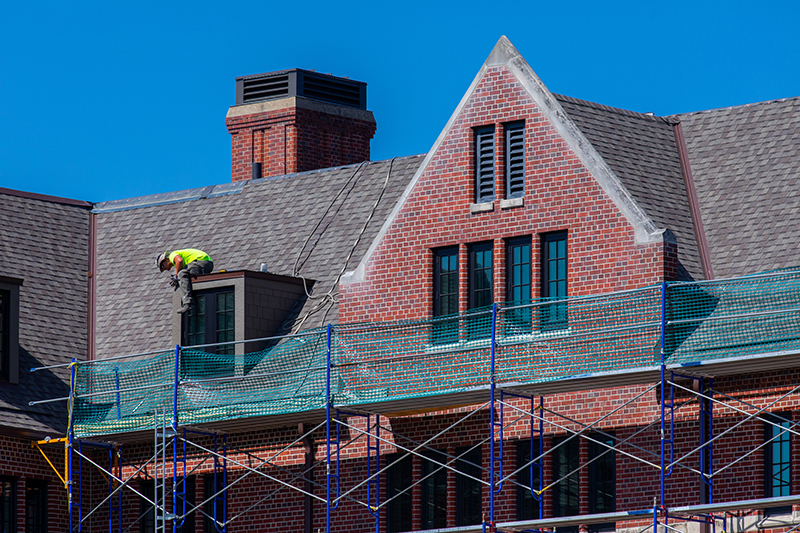
Photos by Christopher Gannon.
August's arrival means the window for summer construction projects will close soon. University photographer Chris Gannon captured images last week from a few project sites around campus.
(top)
2022 is the second of a two-summer project to replace Friley Hall's slate roof with asphalt shingles and replace gutters and downspouts. This project included flat rubber and metal roof areas and all work on Friley's classic top floor dormers -- window replacement, roof and siding. This summer's phase started in the vicinity of Friley Windows dining center and continued north to the end of the residence hall. With the exception of some accessory parts that are delayed, the project will wrap up next week.
(middle)
The athletics department is building a 337-stall RV lot for football gameday tailgaters east of University Boulevard. It's tucked between the southeast recreation fields and Coldwater Golf Links. Concrete parking pads and electrical service bases are in; crews currently are laying sod and installing electric boxes at each site. Behind creekside vegetation south of the RV lot, this project includes a pedestrian bridge over Worle Creek and trail to the University Boulevard bridge to provide safe stadium access to fans who park in lots near the Veterinary Medicine college and a second access to the tailgate area for emergency vehicles. The first home football game is Sept. 3.
(bottom)
Also an athletics department-funded project, small lots on the north and west sides of the Iowa State Center are being connected and enlarged this summer. About 325 stalls -- roughly 10% of them ADA compliant -- will be added to the 150 stalls in the former lots, more than tripling the parking in this area of the center. Crews are pouring concrete curbs and cutouts; the parking surface will be asphalt.
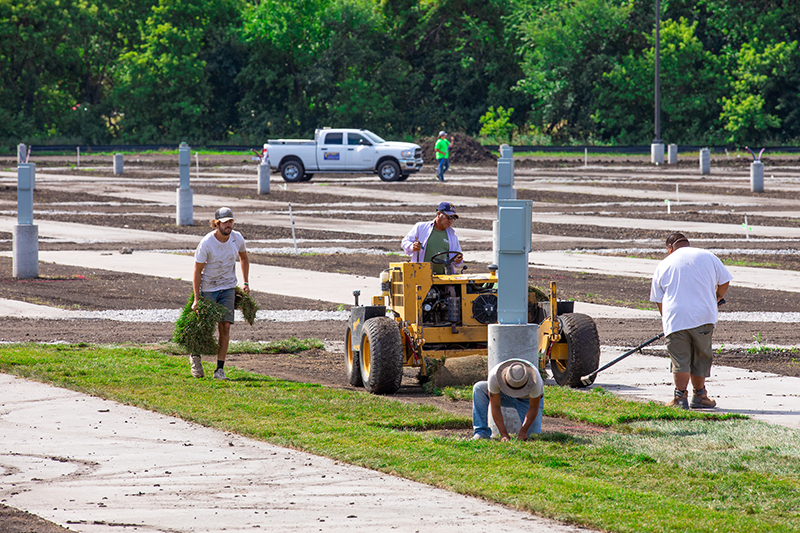
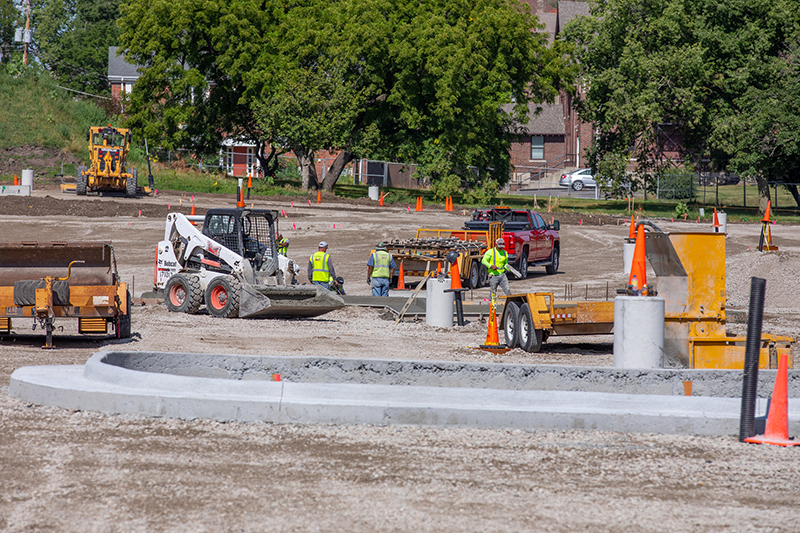
Phase 2 of P&S review moves many to a new pay grade
The first systemwide market review of job profiles since Iowa State's new professional and scientific (P&S) classification and compensation system launched in September 2020 has moved 178 profiles -- roughly 30% of those in the system -- to a higher pay grade in the salary matrix, effective Aug. 1.
The job profile moves impacted about one-third of the university's approximately 3,400 P&S employees, increasing their future earning potential. The salaries of an anticipated 231 employees in the affected group were below the minimum in their new pay grade on Aug. 1, and supervisors have a Jan. 1, 2023, deadline to raise those salaries to the new pay grade minimums. In addition, the salaries of five employees that exceeded their former pay grade now fall within their new pay grade, resuming their eligibility for performance-based increases that are added to their base salaries.
Reminder: What's a job profile?
Formerly known as a classification, a job profile is a set of positions with similar job duties -- often in units across the university -- that require comparable levels of knowledge, training and education. There are more than 600 job profiles, organized among 29 job families, in the P&S classification system. Examples include: academic advisor I, graphic designer III or librarian IV. They provide a high-level overview of a job so compensation decisions are made with consistency.
The pay grade adjustments complete the second of a two-phase review of the P&S staff compensation structure. Phase 1 resulted in a 6% adjustment to the P&S pay matrix on March 1, which made the overall structure competitive in the market. Ahead of the original Oct. 1 deadline, supervisors raised employee salaries to at least the new minimums.
"The two-phase review of the P&S structure is the first of what will be a regular review process," said Kristi Darr, vice president for university human resources (UHR). "We want to keep our structure in a competitive position to allow us to attract and retain talent."
Darr said senior leaders approved all job profile moves where market data showed they should be increased.
UHR shared the changes in separate communications to all supervisors of P&S staff and, subsequently, the supervisors of P&S employees who moved to new pay grades. All impacted P&S employees received their own emails from UHR on July 26.
Neither the phase 1 or phase 2 review alters the category of a job profile (support contributor, individual contributor or manager) or the job duties, qualifications or exemption status.
First review since go-live
UHR compensation analyst Whitney Grote said moving 178 profiles in a single review is a bit unusual, but in this case, not worrisome, for several reasons. The volatility in the job market, both during and on the heels of the COVID-19 pandemic, is the first consideration. The longer time period since implementation (18 months, not 12) accentuates that volatility, she said. And much of it simply has to do with its newness.
"Anytime it's the first review after implementation, you're going to find things that simply weren't where they needed to be at go-live. That's a normal expectation," Grote said.
She also noted the new P&S classification and compensation system was launched six months into the pandemic.
"Budget challenges were a big concern across the university, and leaders made decisions in that climate about how far to advance the structure, given those factors," Grote said. "Senior leaders understood that a measured approach then would lead to the catching up we're doing now."
Grote said she expects the volume of job profile changes during the annual review to stabilize over a few years.
"At go-live, we told the campus community we'd review jobs and maintain the health of this structure. That's what this process is all about," she said.
Many kinds of work impacted
Grote said UHR's classification and compensation team used third-party, HR-verified salary surveys (not data from self-reported options such as salary.com) to ensure individual job profiles remain competitive. She offered these observations about the review process:
- The review team compared job duties, not job titles.
- A majority of the moves are one pay grade; fewer than 30 job profiles moved two pay grades.
- Job profile moves occurred in 23 of the classification structure's 29 P&S job families.
- Within each job category, the ratio of job profiles identified to move is fairly consistent: 27% of support contributor job profiles moved, 33% of individual contributor job profiles moved and 25% of manager-level job profiles moved.
- Not all levels in a job series (for example, accountant, graphic designer or data analyst) moved in this review -- and that's OK. In a market-driven system, the goal is for each profile to be competitive with the market in order to attract and retain talented employees, not to maintain a strict salary separation between the job profiles, Grote said.
Learn more
Five questions with the power plant leads
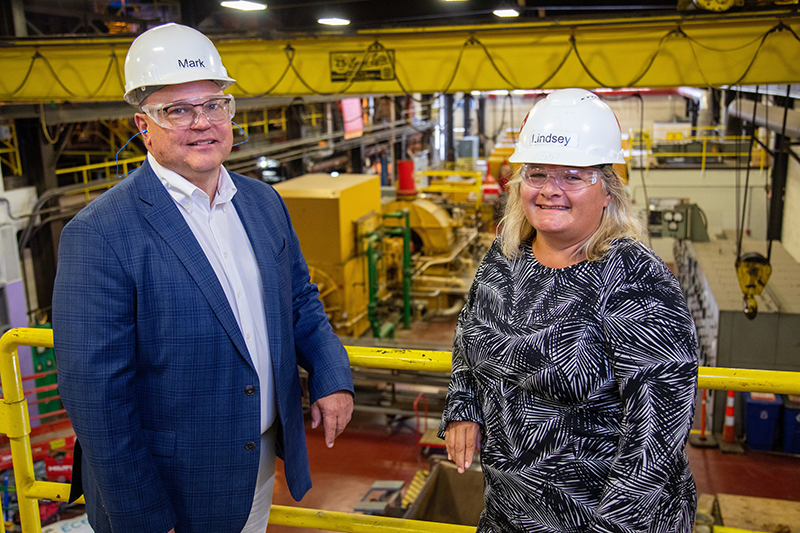
Utility services director Mark Kruse and assistant director Lindsey Wanderscheid above the power plant floor. Photo by Christopher Gannon.
In 2015-16, Iowa State replaced three of the university's five coal-burning boilers with natural gas-powered boilers in a new east addition to the power plant. This spring, contractors began a two-year process to convert the other two boilers to burn natural gas, one this summer and one in the summer of 2023 -- or when they're not in service. The $16 million project includes removing the structures and equipment that supply coal and limestone to the boilers and collect the ash byproduct, installing gas burners and control systems, and expanding the natural gas supply lines into the power plant. The work should wrap up in the spring of 2024.
Assistant director of utility services Lindsey Wanderscheid and director Mark Kruse talked with Inside about the end of Iowa State's 132-year coal era.
Editor's note: Wanderscheid's final day with Iowa State was earlier this week.
Iowa State is replacing one fossil fuel -- coal -- with another, natural gas. Is this a win?
We consider this a stepping stone. Natural gas is a better energy resource than coal, and we need to take incremental steps. Converting these last two coal boilers accomplishes a few things:
- We achieve two goals in Iowa State's five-year (2021-25) strategic plan for sustainability operations: Eliminate coal as a fuel source and reduce carbon dioxide emissions by 35% (based on a 2012 baseline) toward the university's 50% goal by 2025.
- In addition, gas boilers cost less to operate and maintain than coal, which completes the payback period for these two conversions in four years. Many of the structures hugging the east side of the power plant will go away: silos, coal elevator, conveyors, bag houses (in which ash particles are removed from the gases coming out of the coal boilers).
- And finally, there are a lot of emerging technologies out there. This conversion gives us some flexibility to align with renewable energy opportunities as they develop -- while still making this significant step now toward carbon neutrality.
Electricity + heat = cogeneration
Iowa State's boilers burn coal or natural gas to produce steam, which is used first to generate electricity for campus. Depending on the time of year, that steam is distributed around campus to heat buildings or powers equipment that chills water used to cool buildings. Because of cogeneration, the ISU power plant averages 70% efficiency, while a typical power plant might be 35% efficient.
Why not switch to renewable energy sources instead of natural gas?
Our challenge is how to reliably and cost-effectively heat our campus using only renewable energy sources. Fifty percent of the energy we use is for heating buildings (by burning coal or natural gas). Renewable electricity is readily available but can't be used to heat a campus of our size without significant and expensive changes to our utility system and buildings. In our plant, we need thermal energy to produce steam; it's the base for cogeneration. By using natural gas now, we quickly achieve a large reduction in emissions at a lower annual cost.
Is the university using any renewable energy?
Through cogeneration, we make about 52% of our electricity. It's our cheapest source of electricity. The other 48% we purchase from the city of Ames, and it's all renewable: 8-10% of what we use comes from a wind farm in northeast Story County and the community solar farm on Airport Road, and 40% is purchased from renewable energy sources via renewable energy credits (RECs). This actually exceeds the sustainability plan's strategy of "purchasing primarily renewable electricity" for campus.
Iowa State received notice last week we are No. 17 among the top 30 college and university partners in the U.S. Environmental Protection Agency's Green Power Partnership program.
What's next for our five natural gas boilers?
We're getting ready to do a study to look at some future options, consider our current equipment, estimate some costs and see what makes sense for Iowa State. We're in the process of bringing a consultant on board, and we hope to get a study completed in the next year. The possibilities out there include electric, renewable natural gas (from anaerobic digestive processes) or hydrogen-powered boilers, but implementation costs and operation costs right now for those would be staggering. We are sensitive to changes that would have a big impact on the rates our campus users pay.
What will happen to the two outdoor coal storage sites?
The smaller one (east of the power plant) is on a concrete pad that we'll clean and use for equipment or expansions. We'll do some testing on the larger one (north of the railroad berm and east of Haber Road in the Ioway Creek flood plain) to assess what we need to do. The process might involve removing soil and bringing in fill to restore it. We dug up the base several years ago (simply to use that coal) and we hit clay. The idea is that utility services would return that land space to the university.
Tuition increase bolsters operating budget
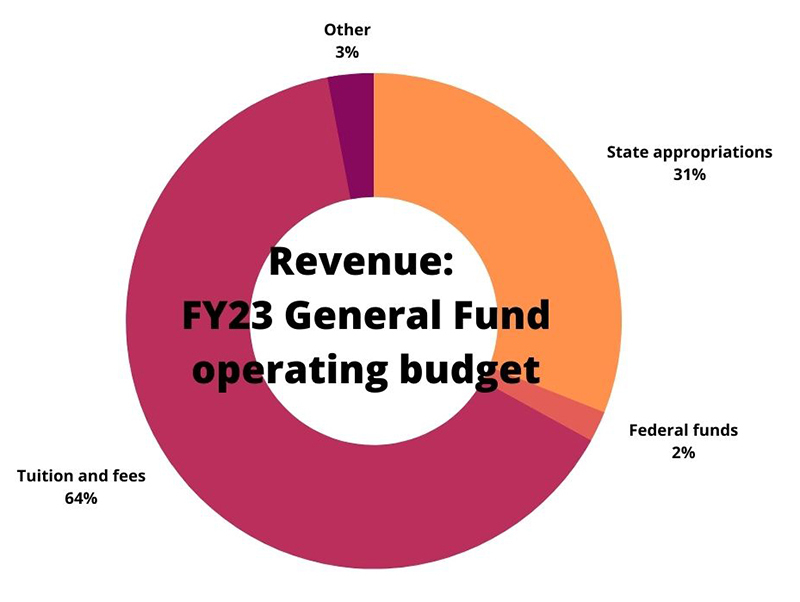
Iowa State's $748.1 million operating budget for the fiscal year that began July 1 includes $25.4 million in new revenue, an increase of about 3.5% over last year's General Fund budget. Most of the increase comes from increased tuition ($21.8 million). Additional state appropriations ($2.1 million) and additional recovery of research-related indirect costs ($1.5 million) are the other two pieces.
The state Board of Regents approved university FY23 budgets and the new tuition and fee rates at its July 27 meeting.
Tuition and fees, estimated at $476.5 million, make up nearly two-thirds (64%) of the revenue in the FY23 operating budget, with state appropriations ($231.5 million) providing nearly a third (31%).
Summary: FY23 state appropriations
In addition to new revenue, the FY23 operating budget will rely on $6.6 million in reallocations to cover additional costs, said associate vice president for institutional financial strategy Bonnie Whalen. New dollars will be invested in financial aid, student physical and mental health resources, disability accommodations, a welcoming campus environment, salary increases and other strategic initiatives.
Priorities for FY23 new and reallocated revenue
|
Salary and benefits* |
$18 million |
|
Student financial aid |
$6.3 million |
|
Annual cost increases** |
$2.6 million |
|
New/strategic initiatives |
$4.4 million |
|
Instructional costs*** |
$0.7 million |
|
Total |
$32 million |
*Includes performance increases, faculty advancement, Merit contract requirements, P&S review market adjustments
**Examples: Insurance premiums, software licenses, City of Ames contracts
***Incremental differential tuition sent to the colleges
Big-picture budget
Iowa State's overall FY23 budget is its largest ever, $1.6 billion. The other part of the university's budget, $857.9 million in restricted budgets, also is higher, about $13.1 million (1.5%), from a year ago. This side of the budget includes sponsored research, endowment income and auxiliary units such as athletics, residence, printing, parking, utilities, recreation services, the bookstore and other units that don't receive state funds.
The restricted budget also includes building projects. Iowa State will receive previously approved state appropriations for two key facilities. The 2022 Legislature altered the timing of state funding for one and left alone a scheduled final appropriation in FY23 for another:
- $28.6 million for Veterinary Diagnostic Laboratory phase 1 construction, to complete the state's $63.5 million commitment to this project one year early. It includes $12.5 million awarded by the 2020 Legislature for FY23 and $16.1 million scheduled for FY24.
- $2 million for construction of the Student Innovation Center, completing the state's seven-year, $40 million support of the project.
Faculty, staff show support for inaugural Cyclone Welcome Weekend
Faculty and staff are showing their Cyclone spirit by welcoming new and returning students to campus during the inaugural Cyclone Welcome Weekend: Camp Iowa State, Aug. 19-20.
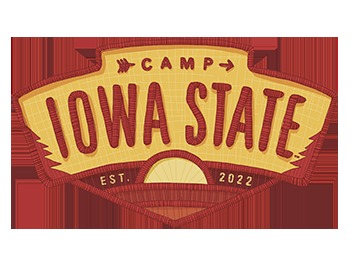
The weekend will provide students healthy, community-building activities, supported by about 140 volunteers. Faculty and staff are giving their time during one of the busiest weekends on the calendar that includes Destination Iowa State for first-year students, residence halls move-in and the Iowa State Fair. Supervisors were asked to encourage and work with employees to adjust their schedules, and it resulted in nearly all of the volunteer positions being filled weeks before the event.
"It's incredible to see the response from our staff and faculty stepping up to support Cyclone Welcome Weekend in addition to the many other events and activities occurring before the start of the semester," said President Wendy Wintersteen. "My deep thanks to the ISU community for helping us live the tenets of our new strategic plan to be the most student-centric leading research university with a welcome and inclusive environment for all."
Volunteers will help set up and clean before and after events, ensure activities run smoothly and welcome students back to campus before classes begin on Monday, Aug. 22. Those who signed up to help by Aug. 1 receive a free T-shirt and their choice of gift card to the ISU Creamery or an ISU Dining café. Volunteers also receive a commemorative event poster and 100 Adventure2 points for those who participate in the ISU WellBeing program.
The weekend has a full schedule of activities, beginning Friday afternoon and concluding early Sunday morning. Friday events include a cookout and volleyball exhibition between Iowa State and Missouri, free for students, at Hilton Coliseum. Saturday begins with a G.O.A.T breakfast followed by a chance to take part in goat (the animal, not Greatest Of All Time) camp calisthenics. The Cyclone football team will scrimmage in front of students only at Jack Trice Stadium from 10:30 a.m. to noon. Students also can enjoy free admission to the Furman Aquatic Center, bingo with celebrity callers and a performance by hypnotist Chris Jones at the Memorial Union. Each night concludes with an outdoor movie on the campanile lawn.
Student affairs staff developed Camp Iowa State this summer and solicited student input on numerous features, including movie titles and celebrity bingo callers. The alcohol- and substance-free activities are designed to help reduce high-risk behaviors associated with the weekend before fall semester begins.
Leadership transition announced for student financial aid office
The office of student financial aid plans a leadership transition for the end of the current fiscal year.
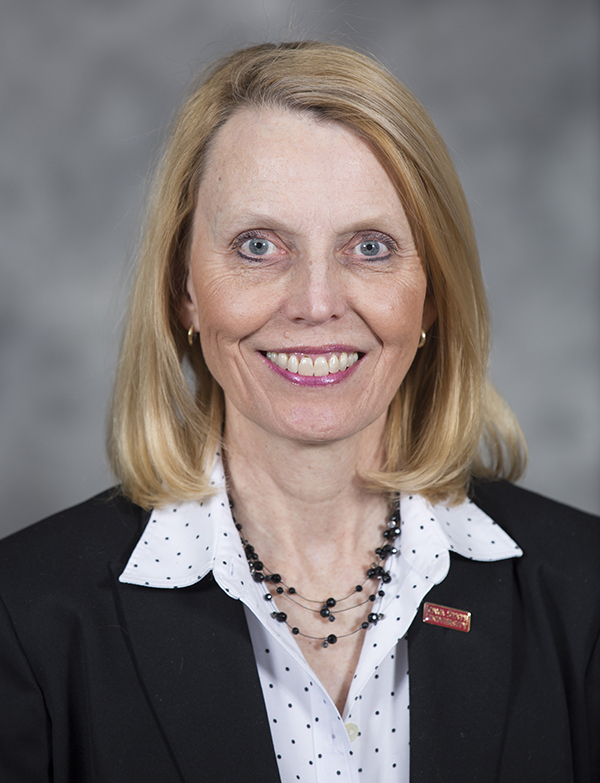
Roberta Johnson
Roberta Johnson, executive director of student financial aid, will retire from Iowa State next summer. She has served the university with distinction over the last four decades; FY 2023 will mark her 20th year as director and 40th year in the financial aid office.
Chad Olson, senior associate director of student financial aid, has been promoted to director of student financial aid operations, effective Aug. 1. Following Johnson's retirement, he will become the unit's sole director.
Associate vice president for enrollment management Laura Doering said the succession plan provides an opportunity to smoothly transition the administration of aid and projects and maintain momentum in enrollment management.
"Chad has long been an outstanding financial aid leader at Iowa State, helping to administer aid strategically to meet recruitment and retention priorities, managing legislative and regulatory changes, and leading staff," Doering said.
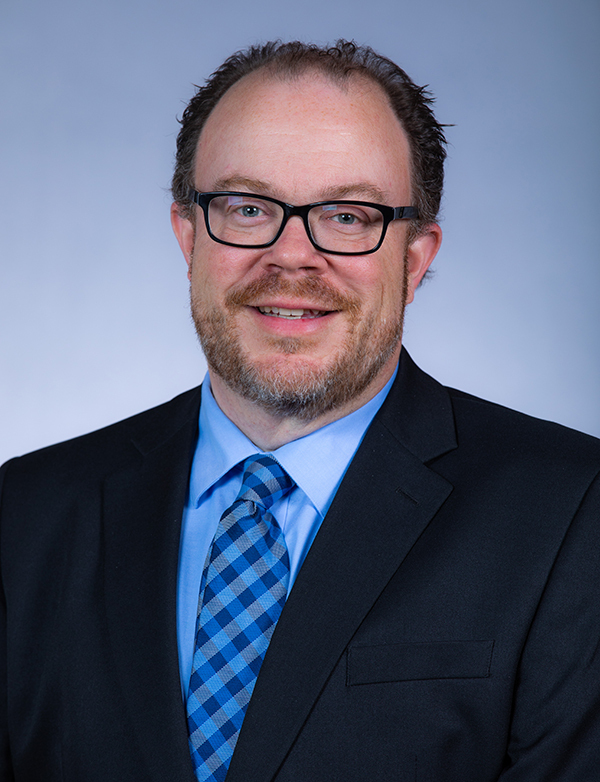
Chad Olson
Olson earned two degrees from Iowa State, a bachelor's in exercise science and a master's in business administration. He joined the office of student financial aid in 2002 as a student loan coordinator. Subsequent roles included assistant director for student loans, associate director for advising and funds management, and, since 2021, senior associate director.
Olson is recognized nationally for his contributions to the discipline and is the only university employee who has completed the National Association of Student Financial Aid Administrators' Certified Financial Aid Administrator program.
A tireless advocate for students
Johnson's stewardship of Iowa State's financial aid budget and her commitment to student success and financial literacy positively impacted countless students over the last 40 years.
Johnson began her Iowa State career in August 1982 as a secretary in the financial aid office and rose through the financial aid advising ranks before being named associate director in 2000. She was named interim director in 2003 and the unit's permanent director in 2005.
"Roberta exemplifies the fundamental and strategic role of Iowa State's financial aid programs, and that is to make a high-quality education both accessible and attainable," Doering said.
Johnson also has provided critical leadership in the development of numerous technology solutions to better serve students and families by creating self-serve options and office efficiencies that enabled staff to focus their efforts on helping students and parents navigate the financial planning process. More recently, she administered COVID-19 federal relief funds to 27,000 Cyclone students.
Regents approve 4.25% tuition increase for 2022-23
Meeting July 27 in Ames, the state Board of Regents unanimously approved a 4.25% tuition increase this fall for undergraduate and graduate students at Iowa State. Excluding differential tuitions, that translates to a:
- $354 annual tuition increase for resident undergraduates, to $8,678
- $432 increase for resident graduate students, to $10,572
- $1,026 increase for nonresident undergraduates, to $25,162
- $1,092 increase for nonresident graduates, to $26,776
Tuition for ISU's professional veterinary medicine students will go up 5% (a $1,258 increase) for residents and 3.5% ($1,938) for nonresidents.
The mandatory student fee package is increasing $145 (11%), to $1,455, primarily to support the increased costs of providing services to students. The increase is derived from increases of $70 (24%) to the technology fee, $24 (9%) to the health fee, $21 (8%) to the student services fee (for CyRide operations), and $30 (9%) to the recreation fee. Most students will pay between 4.5% and 5% more this fall for their combined tuition and mandatory fees.
The tuition and mandatory fee increases will generate an estimated $21.8 million in additional revenue for Iowa State's general fund operating budget. They reflect the board's 2018 tuition guardrails that allow flexibility in setting rates according to state operating appropriations and the projected Higher Education Price Index. Iowa State sought more than $8.7 million in incremental funding from the 2022 Legislature, and received just over $2.1 million in new operating support.
Simplifying differential tuition
With a final differential tuition increase this fall for sophomores in ag systems technology, industrial technology and Engineering majors, Iowa State is completing a multiyear effort to simplify dozens of differential tuition rates into two categories. For resident undergraduates this fall, the two differentials are $1,794 and $2,928.
The regents approved Iowa State's first differential tuition requests for the 2006-07 school year to cover higher costs of instruction. More requests followed in subsequent years. In June 2018, Iowa State proposed its two-tier differential tuition structure.
See how ISU research is part of your everyday life at the Iowa State Fair
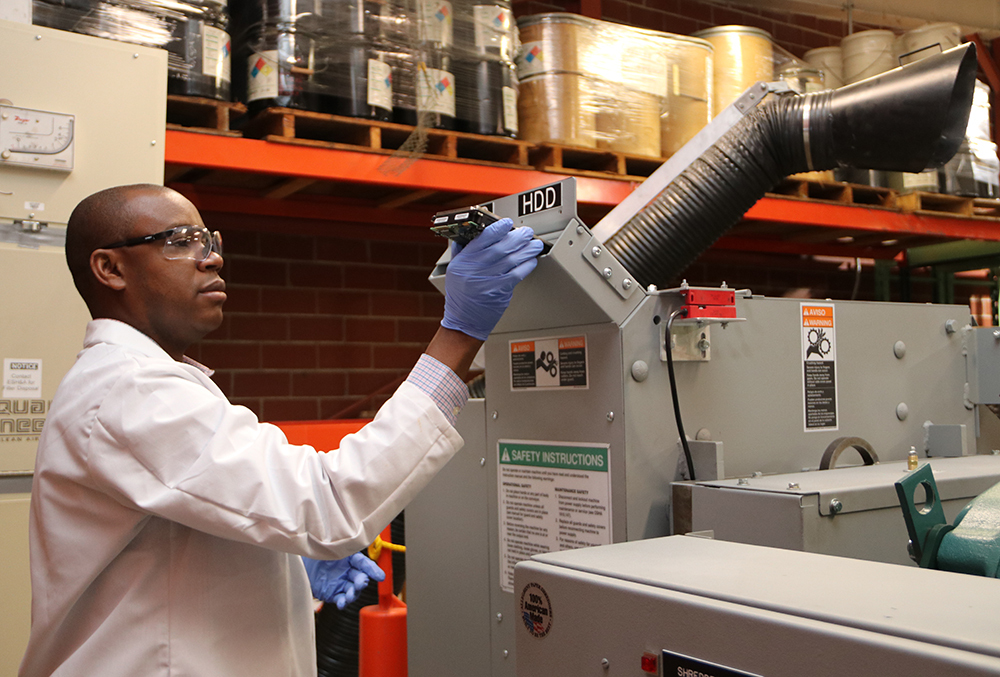
Ames National Laboratory scientist Ikenna Nlebedim loads a hard drive into a specialized shredder that turns obsolete technologies into a mound of pulverized scrap from which scientists can recover and reuse rare-earth metals. Photo courtesy of Ames National Laboratory.
Everyday items like your cell phone and future refrigerator are shaped by research conducted at the Ames National Laboratory.
Ames Lab will demonstrate its innovation in action at the Iowa State Fair as part of its 75th anniversary celebration. Ames Lab is the only U.S. Department of Energy national laboratory located on the campus of a major research university. It began as part of the Manhattan Project and was named a national laboratory by the Atomic Energy Commission (now the Department of Energy) in 1947.
Fairgoers will have an opportunity to learn how Ames Lab is tackling big challenges at Iowa State University's exhibit, "Innovation Revolution," in the Varied Industries Building.
The exhibit will include three interactive stations for attendees to learn how Ames Lab research is impactful in their daily lives, as well as to showcase research on the horizon. The exhibit is open 9 a.m.-8 p.m. every day of the fair, Aug. 11-21.
"When we make materials at Ames National Laboratory, our goal is to solve a problem," said Adam Schwartz, director of Ames Lab and professor of materials science and engineering. "How do we reduce the amount of lead in electronics? How do we address global plastic pollution? How do we make refrigeration systems better for the environment?
"We want Iowans to come away excited about the science that is happening right here in their state."
No toxicity allowed
Lead-free solder, which joins together metals that would otherwise be joined by toxic lead, was invented at Ames Lab and patented in 1996. This safer, more environmentally friendly solder is now used in billions of computers, mobile devices and other electronics.
This section of the exhibit will showcase electronics in which lead-free solder is used.
Steer clear of the landfill
Upcycling is the process of finding new and innovative uses for an item that would otherwise wind up in a landfill. Ames Lab scientists are developing new catalysts that turn discarded plastics into more valuable chemicals by breaking them down into precise components. These components form the building blocks for high-value chemicals that can be used in products like detergents and synthetic oils.
This station will feature a sculpture made from collected plastics, as well as a display of items that will one day be created through the upcycling process, including motor oil, shampoo, deodorant, makeup, sunscreen and soap.
Researchers also are working on ways to recycle critical materials from single-use items, including a new technology that efficiently recovers rare earths and other valuable elements from shredded computer hard drives. Visitors will see how hard drives are broken down through acid-free dissolution and used to create new materials.
Cool in more ways than one
The third station will highlight atomized metal powders, which are used in additive manufacturing, better known as 3D printing. The development of ideal metal powders for industry results in more efficient manufacturing systems, less material waste and more reliable product quality.
This station also will feature CaloriSMART, a one-of-a-kind system that uses magnetic forces to cool 20-25% more efficiently than current gas compression technology in refrigerators.
A trophy, apparel and souvenirs
Visitors to the ISU exhibit also will see the CyHawk trophy and receive football posters and dry temporary tattoos.
The ISU Book Store will have a wide variety of Iowa State merchandise, gifts and apparel for sale, including Farm Strong T-shirts and gifts and new fall game-day gear.
4-H activities are throughout the fair
Look for 4-H youth activities and exhibits in the Bruce L. Rastetter 4-H Exhibits Building, including 3,200 static exhibits and 750 communication performances. In addition, nearly 2,200 4-H youth will exhibit more than 9,000 livestock and horticulture entries in the livestock buildings and other agriculture venues. The colleges of Agriculture and Life Sciences and Liberal Arts and Sciences will award scholarships to selected 4-H'ers.
4-H is headquartered at Iowa State and available in all 99 counties.
4-H Day at the fair is Aug. 12; look for the 4-H Youth Development tent on the Grand Concourse. From 9 a.m. to 5 p.m., explore the 4-H priority areas through hands-on learning experiences. From 11 a.m. to 1 p.m., stop by the tent to receive a cooling towel. A full list of 4-H activities at the Iowa State Fair is online in CyBox.
Those are ISU veterinarians
Two veterinarians from the College of Veterinary Medicine will oversee the health of all animals at the fair. Doctors Rachel Friedrich and Megan Hindman are clinical assistant professors of veterinary diagnostic and production animal medicine. Assisting them will be fourth-year veterinary medicine students Melissa Garcia Rodriguez, Des Moines; Kelsey Gerwig, Winterset; Amberly Van Hulzen, Auburn; and McKenna Von Rentzell, Earlham.
The college will present Aug. 12 and 14 at the Advanced Vet Camp for students in grades 4-7, with Dave Gieseke, communications director for the college, serving as the featured speaker.
At the 40th annual Governor's Charity Steer Show on Aug. 13, College of Veterinary Medicine dean Dan Grooms will show a steer raised by Holland and Carson Rieck of Creston.
